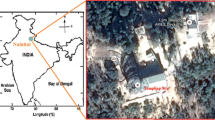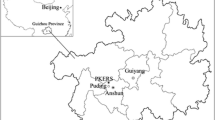Abstract
The present study investigated the chemical composition of rainwater at Kabir nagar, Nari, Nagpur, Maharashtra, India. The rainwater samples were collected on event basis during June–July–August-2006 and were analyzed for pH, major anions Cl, NO3, SO4) and cations (Ca, Mg, Na, K, NH4). The pH value varied from 6.0 to 7.3 (avg. 6.3 ± 0.3) indicating alkaline nature of rainwater. The pH of the rainwater was found well above the reference pH (5.6), showing alkalinity during the monsoon season. The average and standard deviation of ionic composition was found to be 98.1 ± 10.6 μeql−1. The total anions contribute 45.1% and cations 54.9%, respectively to rainwater. Neutralization factors (NF) followed a sequence of NFCa > NFMg > \( {\text{NF}}_{{\text{NH}}_{\text{4}} } \) with factors of 1.1, 0.38 and 0.15 indicating the crustal components are responsible for neutralization of anions. The average ratio of (NO3 + Cl)/SO4 observed as 1.1 indicates that nitric and hydrochloric acid influences the acidity of rainwater. The ratio of NH4/NO3 and NH4/SO4 was observed as 0.68 and 0.34 indicate that the possible compounds which may predominate in the atmosphere are NH4NO3 and (NH4)2SO4. Ionic correlation was established to identify sources of origin. A good correlation was seen between Ca and Mg (r = 0.95); suggesting the common occurrence of these ions from crustal origin. Similarly, the acidic ions SO4 and NO3 correlated well (r = 0.60) indicating their origin from similar sources. Other relatively significant correlations were observed between Ca and SO4 (r = 0.92), Mg and SO4 (r = 0.83), Ca and NO3 (r = 0.09), Ca and Cl (r = 0.34) and Mg and Cl (r = 0.31), and Mg and NO3 (r = 0.71). The observed rainwater ratio of Cl/Na (1.1) is closer to that of seawater ratio (1.16) indicates fractionation of sea-salt and modifications by non-marine constituents as the site is 834 km away from the sea coast. The nss-Ca contribution was observed as 95.7% suggesting their crustal origin whereas nss-Mg and nss-K shows their contribution as 87.9% and 83.2% indicating influence of soil sources. The nss-SO4 contributed as 87.4% shows anthropogenic origin.
Similar content being viewed by others
References
Ali K, Momin GA, Tiwari S, Safai PD, Chate DM, Rao PSP (2004) Fog and precipitation chemistry at Delhi, North India. Atmos Environ 38:4215–4222
Balachandran S, Khillare PS (2001) Occurance of acid rain over Delhi. Environ Monit Assess 71:165–176
Charlson RJ, Rodhe H (1982) Factors controlling the acidity of natural rainwater. Nature 295:683–685
Das R, Das SN, Misra VN (2005) Chemical composition of rainwater and dustfall at Bhubaneswar in the east coast of India. Atmos Environ 39:5908–5916
Galloway JN, Likens GE, Hawley ME (1984) Acid deposition: natural versus anthropogenic components. Science 226:829–831
Hameed AM, Obaidy JA, Joshi H (2006) Chemical composition of rainwater in a tropical urban area of northern India. Atmos Environ 40:6886–6891
Khare P, Goel A, Patel D, Behari J (2004) Chemical characterization of rainwater at a developing urban habitat of Northern India. Atmos Res 69:135–145
Khemani LT, Momin GA, Rao PSP, Pillai AG, Safai PD, Mohan K, Rao MG (1994) Atmospheric pollutants and their influence on acidification of rain water at an industrial location on the west coast of India. Atmos Environ 28:3145–3154
Kulshrestha UC, Kulshrestha MJ, Sekhar R, Sastry GSR, Vairamani M (2003) Chemical characteristics of rainwater at an urban site of south-central India. Atmos Environ 37:3019–3026
Kulshrestha UC, Granat L, Engardt M, Rodhe H (2005) Review of precipitation monitoring studies in India-a search for regional patterns. Atmos Environ 39:7403–7419
Kumar R, Rani A, Singh SP, Kumari MK, Srivastava SS (2002) A long term study on chemical composition of rainwater at Dayalbagh, a Suburban site of semiarid region. J Atmos Chem 41:265–279
Malik A, Singh VK, Singh KP (2007) Occurrence and distribution of persistent trace organics in rainwater in an urban region (India). Bull Environ Contam Toxicol. doi:10.1007/s00128-007-9290-8
Moody JL, Pszeny AAP, Gaudry A, Keene WC, Galloway JN, Polian G (1991) Precipitation chemistry and its variability in the southern Indian Ocean Amsterdam Island 1980–1987. J Geophys Res 96(DII-20):769–786
Mouli CP, Venkatamohan S, Reddy JS (2005) Rainwater chemistry at a regional representative urban site: influence of terrestrial sources on ionic composition. Atmos Environ 39:999–1008
Parmar RS, Satsangi GS, Lakhani AL, Srivastava SS, Prakash S (2000) Simultaneous measurements of ammonia and nitric acid in ambient air at Agra (27 10N and 28 05E). Atmos Environ 35:5979–5988
Ramsey MH, Thompson M, Hale M (1992) Objective evaluation of precision requirements for geochemical analysis using robust analysis of variance. J Geochem Expl 44:23–36
Rastogi N, Sarin MM (2005) Chemical characteristics if individual rain events from a semi-arid region in India: three-year study. Atmos Environ 39:3313–3323
Safai PD, Rao PSP, Momin GA, Ali K, Chate DM, Praveen PS (2004) Chemical composition of precipitation during 1984–2002 at Pune, India. Atmos Environ 38:1705–1714
Salve PR, Maurya A, Sinha R, Gawane AG, Wate SR (2006) Characterization and source identification of major inorganic ions in precipitation of Nagpur, India. Bull Environ Contam Toxicol 77:305–311
Seinfield JH (1986) Atmospheric chemistry and physics of air pollution, vol 219. John Wiley and Sons, New York
Singh AK, Mondal GC, Suresh K, Singh KK, Kamal KP, Sinha A (2007) Precipitation chemistry and occurrence of acid rain over Dhanbad, coal city of India. Environ Monit Assess 125:99–110 doi: 10.1007/s10661-006-9243-4
Tham YWF, Sakugawa H (2007) Preliminary study of the photolysis of fluorene in rainwater. Bull Environ Contam Toxicol. doi:10.1007/s00128-007-9309-1
Acknowledgments
The research study was carried out to assess the chemistry of rainwater during monsoon season. The work was supported by Project No. C-7-1425. The authors thank to D.R. Satapathy for reviewing the manuscript.
Author information
Authors and Affiliations
Corresponding author
Rights and permissions
About this article
Cite this article
Salve, P.R., Maurya, A., Wate, S.R. et al. Chemical Composition of Major Ions in Rainwater. Bull Environ Contam Toxicol 80, 242–246 (2008). https://doi.org/10.1007/s00128-007-9353-x
Received:
Accepted:
Published:
Issue Date:
DOI: https://doi.org/10.1007/s00128-007-9353-x




